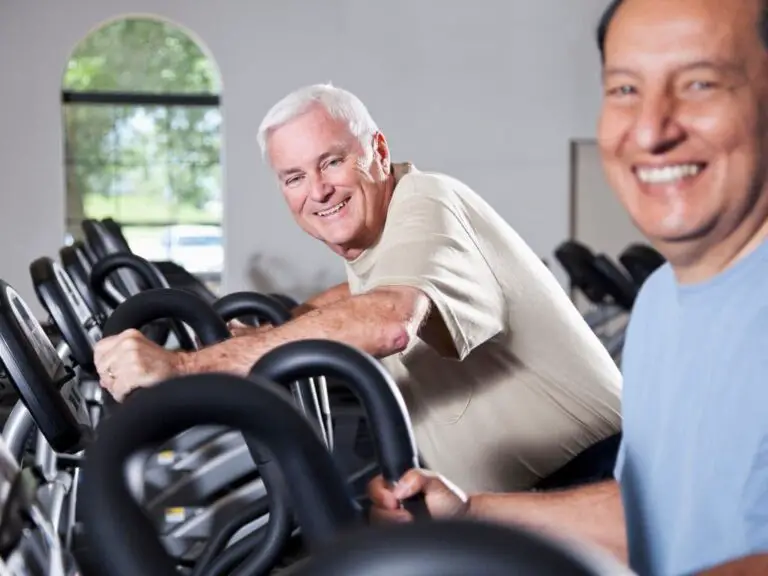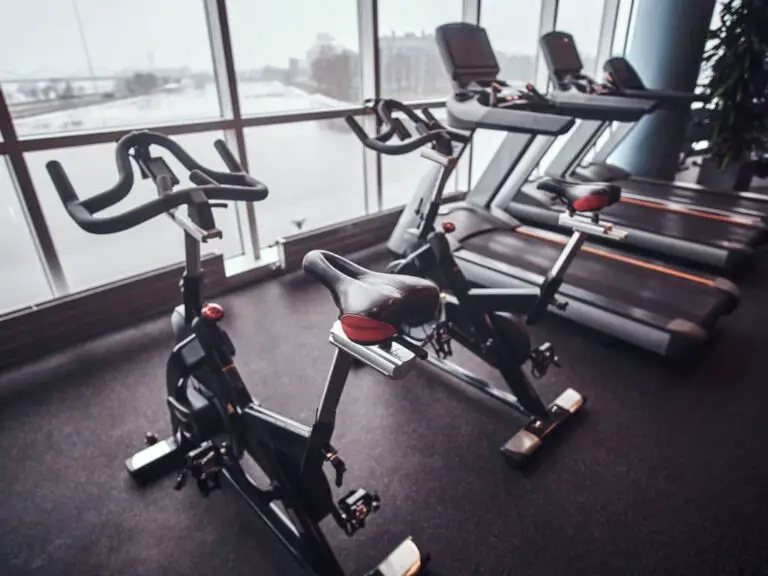How Many Reps Should a Senior Do?
As we get older, maintaining muscle mass and strength becomes increasingly important for overall health and fitness. Resistance training or weight training provides many benefits for seniors, including building strength, preventing muscle loss, improving balance and mobility, supporting joint health, preventing falls and injuries, and enhancing mental sharpness. But to gain these benefits, it’s important for seniors to follow proper guidelines for strength training safely and effectively.
One key question is: how many repetitions or reps of each exercise should a senior do?
Seniors starting a strength training program should typically aim for 8-12 repetitions of each exercise. This builds muscle strength and endurance safely. As they get stronger, they can gradually increase the reps to 15 or more. However, they should always listen to their bodies, pay attention to any discomfort, and maintain proper form to avoid injuries.
Here is a table showing recommended number of reps for senior citizens at different ages:
| Age | Recommended Reps |
|---|---|
| 50-59 | 12 |
| 60-69 | 8-12 |
| 70-79 | 8 |
| 80+ | 6-8 |
The recommendations are based on the following:
- Research recommends doing 10 reps per exercise for most people.
- As people get older, they may need to reduce the reps to avoid injury.
- For people in their 60s, a range of 8-12 reps is recommended.
- For people in their 70s, 8 reps is recommended.
- For people ages 80+, a range of 6-8 reps is recommended.
As an example, here are the recommended sets and reps for a 70 year old man doing the Growing Stronger exercise program:
- Sets: 2 sets per exercise
- Reps: 8 reps per set
So for each exercise, the recommendation would be:
- Complete 8 reps
- Rest 1-2 minutes
- Complete a second set of 8 reps
Some key points:
- Two sets per exercise is the standard recommendation in the program, regardless of age.
- For people in their 70s, the recommended reps are 8 reps per set instead of the standard 10 reps. This reduces risk of injury.
- It’s important to rest 1-2 minutes in between sets to allow the muscles to recover.
- Proper form should be maintained for all reps. The reps can be reduced further if needed to maintain good form.
- The weight/resistance should be challenging but allow 8 reps to be completed with good form.

What are the Benefits of Strength Training for Seniors?
Strength training is highly beneficial for seniors for many reasons. As we age, we naturally lose muscle mass and strength due to changes in hormone levels and decreases in physical activity. This condition is known as sarcopenia. Resistance training helps seniors build and maintain muscle mass and strength. It also helps improve muscular endurance – the ability of muscles to work hard over an extended period of time.
Here are some of the key benefits of strength training for seniors:
- Builds strength to perform daily activities like climbing stairs, lifting objects, and walking independently.
- Maintains bone density to reduce risk of osteoporosis and fractures.
- Improves balance and stability which helps prevent falls and injuries.
- Supports joint health to reduce arthritis pain and stiffness.
- Boosts metabolism and aids with weight control.
- Reduces risk of heart disease, diabetes and other chronic illnesses.
- Enhances mental sharpness and reduces symptoms of depression.
Overall, resistance training allows seniors to stay active and independent as they age. It is considered extremely safe when done properly using moderate weights and correct form.
How Many Reps Should a Senior Do in Strength Training?
When starting a strength training program, seniors should begin by determining how many repetitions, or reps, to do for each exercise. The right number of reps depends on your individual fitness level, specific goals, and any health concerns. Here are some general guidelines:
- 8-12 repetitions – This is a good starting point for most seniors who are new to strength training. Lifting moderately challenging weights for 8-12 controlled reps helps build muscular strength and endurance safely.
- Increase reps as you get stronger – After a few weeks, if you can do more than 12 reps easily, you can gradually increase the number of reps to 15 or more to continue building strength. Adding reps builds muscular endurance.
- Listen to your body – It’s important to pay attention to any pain or discomfort during or after lifting. Stop an exercise immediately if you feel pain. Decrease the weight or reps if needed.
- Use proper form – Completing each rep slowly and with correct posture is key. Never sacrifice form to lift more weight or do more reps. Poor form leads to injury.
The right number of reps for you depends on your current abilities. Build up slowly, allowing your body to adapt. It’s better to start with lighter weights and more reps until your fitness improves.
How Can Seniors Safely Engage in Strength Training?
To gain the benefits of strength training while staying safe, seniors should follow these guidelines:
- Use lighter weights – Lifting very light weights is unlikely to injure muscles or joints. Start with 1-3 lb dumbbells or resistance bands.
- Focus on proper form – Keep good posture and move slowly and smoothly without jerking weights. Avoid “locking out” joints.
- Limit sets – For beginners, 1-2 sets of each exercise is sufficient to see benefits. Do not overdo it.
- Allow rest between workouts – Take at least 1 day of rest between sessions to avoid overuse injuries. Strength train 2-3 days per week.
- Listen to your body – Pay attention to pain signals. Joints and muscles need time to recover, especially when you are new to strength training.
- Consult your doctor – Speak with your physician before starting a new exercise regimen, especially if you have any health concerns.
With moderate weights, controlled movements, and close attention to your body’s signals, seniors can safely perform resistance training to gain strength, mobility, and fitness.
What are Some Common Injuries in Strength Training for Seniors?
When performing strength training, seniors need to take extra precaution to avoid these common injuries:
- Muscle strains – Overextending a muscle can lead to tears in the muscle tissue. Warm up thoroughly and increase weights gradually.
- Joint pain – Too much weight or reps can inflame joints. Focus on proper form and full range of motion.
- Back pain – Heavy lifting with poor posture stresses the back. Keep back straight and lift with hips and knees.
- Tendinitis – Repetitive lifting causes inflammation of tendons. Vary exercises and allow for rest periods.
- Fractures – Osteoporosis increases fracture risk. Use lighter weights and avoid high impact exercises.
- Hernias – Straining with heavy weights can cause abdominal hernias. Lift smart, not hard.
Following safety precautions, listening to your body, and consulting a trainer can help avoid injuries as you gain strength.
How Can Seniors Progress in Strength Training?
As seniors get stronger with regular resistance training, they can progress by:
- Gradually increasing weight – Add 1-2 lbs or move to the next resistance band level once an exercise becomes too easy.
- Adding more reps – Build up to 3 sets of 12-15 reps of each exercise before increasing weight.
- Trying new exercises – Vary your routine by incorporating new strength training moves that target different muscle groups.
- Increasing frequency – Build up to strength training 3-4 days per week for added benefits. Allow at least 1 rest day between sessions.
- Maintaining good form – Continue to focus on correct posture and controlled movements as you progress. Lifting heavier without proper form leads to injury.
The key is to increase intensity slowly over time to continually challenge your muscles. Listen to your body and don’t progress too rapidly. Be patient and your strength will build.
How Can Seniors Choose the Right Exercises for Strength Training?
Choosing the right strength training exercises involves selecting moves that target all the major muscle groups, including:
- Legs – squats, leg presses, leg curls, calf raises
- Hips & glutes – bridges, lunges
- Back – lat pulldowns, seated rows
- Chest – pushups, chest press
- Shoulders – shoulder presses, lateral raises
- Arms – bicep curls, tricep extensions
- Core – crunches, plank holds
Focus on low-impact bodyweight exercises and moves using resistance bands, light dumbbells or machines. Avoid lifting heavy weights overhead or high-impact exercises like jumping.
Seniors should also choose exercises that improve balance like leg stands and incorporate functional moves like chair squats or step-ups. Always put safety first and check with your doctor about exercise if managing any health conditions. With the right approach, nearly everyone can benefit from strength training.
Conclusion
Strength training provides tremendous benefits for seniors – from building muscle and bone strength to maintaining mobility and preventing injuries. Following the guideline to start with 8-12 repetitions using proper form is a safe approach for most older adults beginning a resistance training program. Over time, as your fitness improves, you can gradually increase the number of reps and sets, add more weight, and incorporate new exercises to continue gaining strength. With patience and persistence, seniors can achieve higher levels of health and fitness through strength training.
Frequently Asked Questions
-
What causes muscle loss in elderly?
Age-related sarcopenia, or sarcopenia associated with aging is the cause. After age 30, people who are physically inactive can see a loss of 3%-5% of muscle mass. You will still experience some muscle loss, even if your activity level is high. Sarcopenia is not diagnosed by a specific test.
-
How can seniors build muscle fast?
For older adults, strength training is key to increased muscle mass. This is best done slowly and with lighter weights. Your muscles will work harder if you move slowly with lighter weights. You don’t need a set weight to do resistance exercise like push-ups or squats if you don’t have any.
-
Can muscle wasting be reversed?
Although it is possible to reverse the effects of physiologic (disuse) atrophy, this will not happen in an instant. Muscle atrophy can be reversed by regular exercise and a balanced diet. Although you may notice some improvement in a couple of months, it might take longer to recover all your strength.
-
At what age do you stop building muscle?
Around 40, muscle mass peak. Pete Rufo from Beast Training Academy, Chicago, says that muscle mass begins to decrease after age 40. Lack of exercise and sedentary living are major factors in muscle mass loss.
-
Can elderly people drink whey protein?
Research shows that Whey Protein Supplements promote protein synthesis among the elderly. They improve muscle performance, aerobic capacity and protect against sarcopenia.
-
How soon will I see results from lifting weights?
A visible difference can be seen in three to four weeks. After 12 weeks you will start to see real changes, however, it all depends on what goals and strength training methods are used, says Haroldsdottir.
-
What causes muscle wasting in the elderly?
Age-related sarcopenia, or sarcopenia associated with aging is the cause. After age 30, people who are physically inactive can see a loss of 3%-5% of muscle mass. You will still experience some muscle loss, even if your activity level is high. Sarcopenia is not diagnosed by a specific test.
-
Will walking 2 miles a day tone my legs?
Walking benefits for legs Muscle tissue is four times more efficient at burning calories than fat. Therefore, walking may help you to lose weight. Walking for at least 60 minutes each day can help you trim fat and tone your legs in a matter of months.
-
Is 20 pushups a day good?
You can perform as many push-ups per day as you like. Some people can do 300 or more push-ups per day. If done correctly, 50-100 push-ups is enough for an average person to keep a strong upper body. Start with just 20 push-ups. Do not limit yourself to that number.
-
How many times a week should I lift weights to gain muscle?
At least three times per week, you should be lifting weights. Research suggests that you should be lifting weights at least twice per week to increase muscle mass.
-
How many reps should a senior do?
It is recommended to do 8-12 repetitions, and 2 to 3 sets. However, you may be able to get stronger by doing just one set. You can start with a lighter weight and more reps and then gradually increase your resistance to higher reps.
-
Why do old peoples legs get skinny?
As you age, there will be a gradual loss in lean muscle mass. This is most noticeable in the arms and legs. As we age, muscle mass decreases over time. However, if too much of it happens, the condition is called sarcopenia. This literally means “poverty in the flesh”.
-
What are the signs of muscle loss?
Muscle atrophy can cause balance issues, muscle weakness, facial weakness and tingling sensations in the arms and legs. It also causes vision problems and fatigue. Some people with the condition may also have difficulty swallowing and speaking.
-
How long should I be able to plank?
What is the maximum length you should hold a plank for? Although the world record time for holding a plank was more than 4 hours, it is not necessary to do so. Experts recommend that you hold a plank for between 10 and 30 seconds.
-
Can 70 year old take whey protein powder?
Whey protein can help seniors gain weight if it is incorporated into their diets and consumed on a consistent basis. As we age, our ability to use our bodies as we get older causes a decline in lean muscle mass. This can lead to functional decline and decreased independence. Whey protein can be taken by seniors to build strength and muscle.






